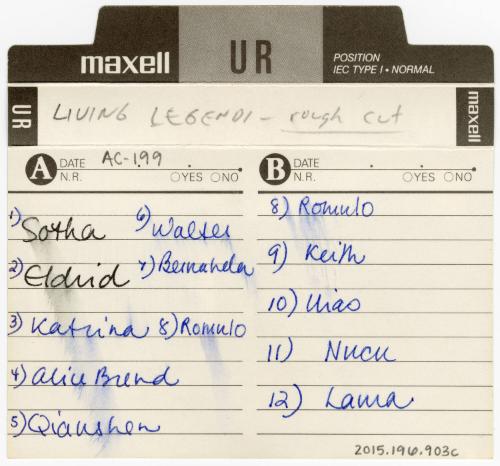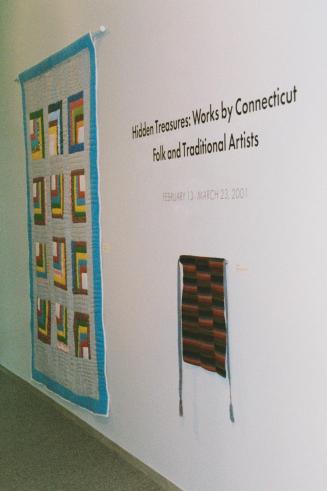Living Legends Project: Rough Cut of Artist Interview Clips for Video
RecorderRecorded by
Dr. David Shuldiner
PerformerPerformed by
Sotha Keth
(Cambodian)
PerformerPerformed by
Eldrid Arntzen
PerformerPerformed by
Katrina Benneck
(German)
PerformerPerformed by
Qianshen Bai
(Chinese)
PerformerPerformed by
Bernabela Quiñones
(Puerto Rican, born 1900)
PerformerPerformed by
Romulo Chanduvi
(Peruvian)
PerformerPerformed by
Nucu Stan
(Romanian, born 1955)
Date1994
Mediumreformatted digital file from audio cassette
DimensionsDuration (side 1): 47 Minutes, 3 Seconds
Duration (side 2): 26 Minutes, 11 Seconds
Duration (total runtime): 1 Hours, 13 Minutes, 21 Seconds
ClassificationsInformation Artifacts
Credit LineConnecticut Cultural Heritage Arts Program collections
CopyrightIn Copyright
Object number2015.196.903a-d
DescriptionAudio cassette tape recording with the rough cut of clips from artist interviews, to be used for the background audio track for the Living Legends exhibit video. The tape was compiled by Lynne Williamson and David Shuldiner in 1994. The recorded artists include: Sotha Keth, Eldrid Arntzen, Katrina Benneck, Alice Brend, Qianshen Bai, Walter Scadden, Bernabela Quiñones, Romulo Chanduvi, Keith Mueller, Ilias Kementzides, Nucu Stan, and Laura Hudson.
NotesSubject Note: Living Legends: Connecticut Master Traditional Artists was a multi-year project to showcase the excellence and diversity of folk artists living and practicing traditional arts throughout the state. The first CCHAP Director, Rebecca Joseph, developed the first exhibition in 1991, displaying photographic portraits along with art works and performances representing 15 artists from different communities, at the Institute for Community Gallery at 999 Asylum Avenue in Hartford. In 1993, the next CCHAP Director, Lynne Williamson, organized two exhibitions of the photographic portraits from the original Living Legends exhibit at the State Legislative Offices and at Capital Community-Technical College in Hartford. The photographs were also displayed in the Capitol Rotunda in Washington, DC in October 1994, with the help of Rep. Nancy Johnson. Also in 1993, a grant from NEA Folk Arts was awarded to CCHAP to expand and tour the original exhibit and create a video to accompany it. The Connecticut Humanities Council and the Connecticut Commission on the Arts supported an exhibit catalogue and a performance series. CCHAP began fieldwork around the state in 1994 to document several of the artists involved in the first exhibit, adding new artists. The expanded version of Living Legends opened at ICR's Gallery at its new office space at 2 Hartford Square West, then traveled to several sites in 1994 and 1995, including the Norwich Arts Council, the Torrington Historical Society, and the New England Folklife Center, Boott Mills Museum at Lowell National Historical Park in Lowell Massachusetts. CCHAP along with folklorist David Shuldiner created a video based on images taken of the artists at work and interviews conducted with them. Portraits and images of the artists working were taken by photographer Gale Zucker. A catalogue of the images, art works, and texts based on the artist interviews was compiled by CCHAP and designed by Dan Mayer who also served as the exhibition designer.Thirteen visual artists were included in the new Living Legends project: Eldrid Arntzen, Norwegian rosemaling; Qianshen Bai, Chinese seal carving; Katrina Benneck, German scherenschnitt; Alice Brend, Pequot ash basket making; Romulo Chanduvi, Peruvian wood carving; Laura Hudson, African-American quilt making; Ilias Kementzides, Pontian Greek lyra making and playing; Sotha Keth and Sophanna Keth Yos, Cambodian dance costume making; Keith Mueller, decoy carving; Bernabela Quiñones, Puerto Rican mundillo lace; Walter Scadden, decorative ironwork; Nucu Stan, Romanian straw pictures. Five performing artists were presented: Sonal Vora, Indian Odissi dance; Somaly Hay, Cambodian court dance; Ilias Kementzides, Pontian Greek lyra; Abraham Adzenyah, Ghanaian music and drumming; and La Primera Orquesta de Cuatros, Puerto Rican cuatro group.
The profound way these artists describe their inspirations, their intricate technical processes, and the dynamic tension they feel between traditional form and personal innovation within that form mark them as true creative masters. The artists featured in Living Legends had very different characters, stories, homelands, communities, art forms and techniques, but they were linked by their high level of artistic skill and a devotion to the traditions of their culture. The Living Legends project highlighted the way that cultural histories, technical information, aesthetic tastes, social values and other deep aspects of heritage can be communicated through the process and creation of traditional arts. Also, these artists express a strong desire to teach what they know to others, to "pass on the tradition." Community survival, memories of the past, and hopes for the next generation depend on exemplary culture bearers such as these.
Biographical Note: Folklorist Dr. David Shuldiner served as the Humanist in Residence at the Department of Social Services Elderly Services Division, State of Connecticut. A trained folklorist, his recent projects have included production of a slide program (transferred to video format) on the lives of older workers from a variety of Connecticut's industries. A strong supporter and colleague of CCHAP and many cultural activities in Hartford, in 1994 he collaborated with CCHAP on the video featuring interviews and images of the artists in the Living Legends project, and he authored an essay in the exhibit catalogue on “Creativity and Community” among these artists in Connecticut.
Additional materials exist in The CCHAP archive for these artists and this project.
Cataloging Note: This project was made possible in part by the Institute of Museum and Library Services MA-245929-OMS-20.
Status
Not on view











